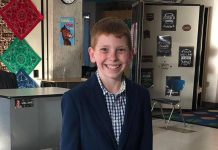When he was in sixth grade, Brian Irwin’s teacher told his mother she hoped he would use his intelligence to create a better future.
And now the 56-year-old Northside Middle School art teacher is taking his first steps toward doing just that.
After working for six years on a project he was not sure would come together, the United States Patent Office has awarded Irwin a 20-year patent for a product that will cut down on toxin contamination in the home and workplace.
“That’s a pretty big deal,” said Amy Dixon, principal of Northside Middle School.
Irwin’s now-patented “drip containment apparatus system and method” is structured around a common household item: the funnel.
Funnels serve a variety of purposes in the home and workplace, Irwin said, such as siphoning gasoline, landscaping work or water displacement.
But many of those purposes leave behind toxins, carcinogens and other harmful substances, which then seep out of the funnel and into the home, workplace or environment.
“A typical dilemma is that spills occur, and an absorbent material is thrown on the oil or whatever it is and soaks it up, but then what to do with this absorbent material?” Irwin said. “It goes in the trash can, and then it ends up in a landfill.”
Irwin’s product, however, seeks to capitalize on the absorbent properties of clay, which will absorb liquids when left unglazed.
His concept places a funnel inside a structure with an unglazed clay interior, allowing the container to absorb any toxic liquids before they are dispersed.
The exterior of the structure would be glazed clay, which is non-permeable.
“Nothing’s getting through this,” Irwin said.
And as an added bonus, Irwin’s product is an eco-friendly design.
If the clay structure is re-fired, the liquids that were absorbed into the body of the container are boiled away, making the product reusable for a seemingly infinite number of times.
“This is a green type of product,” Irwin said.
But arriving at a safe, reusable product took Irwin six years of trial, error and waiting.
In 2009, the Northside art teacher was first inspired to study the absorbancy of clay while leading his classes through a ceramics project.
He held onto the idea, even creating prototypes in his garage, until finally, last fall, he decided to seek the help of local intellectual property attorney John Roberts.
“It was dogging me. I was thinking, ‘Is this viable? Is this going to work?'” Irwin said.
Roberts researched Irwin’s idea and discovered that it was a completely unique product on the market, which meant Irwin was eligible for a patent.
“As soon as I sat (the prototype) down on the table, John looked at me and said, ‘I know that problem,'” Irwin said. “And immediately he looked it up and got pretty fired up because there’s nothing like this out there.”
In October 2014, Irwin and Roberts filed the initial patent application with the U.S. Patent Office, where they had the process fast-tracked.
In December, however, the office denied Irwin’s request, saying his concept was too similar to another idea the office found in an online blog post.
That post argued that scented oils inside an unglazed clay structure would diffuse and release scents, much like a scented candle.
Despite the setback — and the belief that his product had nothing in common with the blogger’s idea — Irwin and Roberts filed a rebuttal and re-wrote the patent in a way that highlighted its unique nature.
“That’s a one lesson (for his students), is to keep trying even if at first you don’t succeed,” Dixon said.
In June, their efforts proved worthwhile, when the patent office finally approved Irwin’s idea.
“It was a win-win because we got accepted, and it was written in such a way as to basically bolt the door shut on anyone who thinks, ‘Oh, I can do this and get around it,'” Irwin said. “No, you can’t.”
Irwin also filed an international patent application, which gives him the rights to his idea in 148 countries around the world.
However, he has not filed an official patent in any of the eligible countries yet. Instead, as a cost-saving measure, he is waiting for a foreign business to approach him about producing his idea internationally.
Irwin also submitted an application for a divisional patent, which is an offshoot of the original product. That patent would create a way to mount his absorbancy device to the wall.
Going forward, Irwin said he hopes to meet with ceramics, funnels and other retailers and manufacturers who might be interested in producing and selling his product.
While he has a few names in mind, Irwin said he is hesitant to narrow his list of potential vendors because he does not want to overlook any potential opportunities.
“The sky’s the limit,” he said.
And while much remains unknown, Irwin hopes the journey that finally brought him to his dream will be an inspiration to his students.
“I tell my kids, the most important thing they can have is an idea,” Irwin said. “But the second most important thing is to act on that idea.”
[sc:pullout-title pullout-title=”Timeline of patent development” ][sc:pullout-text-begin]
2009: Irwin begins observing, studying absorbent properties of clay.
October 2014: Irwin and attorney John Roberts file initial patent application.
December 2014: U.S. patent office rejects Irwin’s product.
March 2015: Irwin and Roberts file rebuttal with U.S. patent office.
June 2015: Patent accepted
Sept. 8, 2015: Irwin officially awarded U.S. patent.
Sept. 8, 2035: Patent expires
[sc:pullout-text-end][sc:pullout-title pullout-title=”Irwin bio” ][sc:pullout-text-begin]
Originally from Madison, Indiana, 56-year-old Brian Irwin said he has always been drawn to Columbus by its famed architecture and progressively-thinking residents.
Although he’s now a Brown County resident, Irwin began his work in Columbus in 1987, when he was a coach with the Donner swimming program, a position he held until 1993.
In 1988, Irwin began teaching at Northside Middle School, and from 1990-1998 he served as the boys swimming coach at Columbus East High School.
[sc:pullout-text-end]




